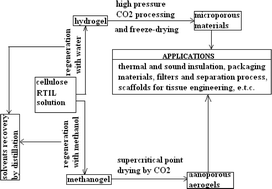Three lines of green chemistry were combined in this study, in order to produce porous materials with pore size distributions in the micro- and nano-scales. These lines are: (i) the renewable and biodegradable sources (cellulose), (ii) ionic liquids, and (iii) supercritical fluids. By dissolving cellulose in a room temperature ionic liquid and regenerating with water or methanol we obtained cellulose hydrogels and methanogels. The liquid mixtures were separated by vacuum distillation with high yield of recovery. The obtained gels were processed by supercritical carbon dioxide to give porous materials. A novel foaming procedure was applied to hydrogels in order to obtain microporous structures of cellulose and cellulose composites, while in alcogels the supercritical point drying method resulted in nanoporous aerogels. For elucidating physicochemical aspects involved in the two processes and for characterization of the produced materials, X-ray diffraction, sorption measurements (by a modified mass loss analysis and the BET method) and scanning electron microscopy were used. The role of various process parameters on the final porous structure was investigated.

You have access to this article
 Please wait while we load your content...
Something went wrong. Try again?
Please wait while we load your content...
Something went wrong. Try again?


 Please wait while we load your content...
Please wait while we load your content...